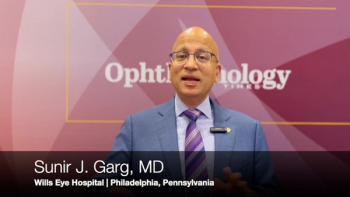
- Ophthalmology Times Europe January/February 2023
- Volume 19
- Issue 01
Dry AMD: A review of ongoing, completed and future treatments
The most promising recent interventional trials for investigational therapies in dry age-related macular degeneration are highlighted by the authors.
Age-related macular degeneration (AMD) is the leading cause of irreversible blindness in the elderly, with 288 million individuals predicted to be affected by 2040,1 which creates a significant societal cost burden. With the increase in life expectancy, this burden will become greater, and arguably unsustainable, in the foreseeable future.2
There is no cure or effective treatment currently approved for the non-neovascular form of AMD, although a multitude of therapeutic approaches are being investigated, which are reviewed in this article.
Antioxidant therapies/nutritional supplementation
Age-related eye disease study (AREDS) supplements
AREDS (NCT00000145 and NCT00594672), which was the largest multicentre trial for dry AMD, investigated the effects of antioxidant supplementation in affected individuals (n = 3640). A daily dose of vitamin E, vitamin C, beta-carotene, zinc oxide and cupric acid reduced the odds of developing advanced AMD in more than one-third of subjects with high-risk characteristics.3
Subsequently, AREDS2 (NCT00345176) explored a new formulation composed of lutein, zeaxanthin and omega-3 polyunsaturated fatty acids in 4203 affected individuals, revealing no further significant reduction in the risk of developing advanced AMD.4,5
OT-551
The antioxidant eyedrop OT-551 (Othera Pharmaceuticals) was explored in a phase 2 trial (NCT00306488) after it demonstrated successful protection against retinal pigment epithelium (RPE) degeneration in preclinical models. Eleven individuals with bilateral geographic atrophy (GA) received topical 0.45% OT-551. Although the drug was deemed to be safe, no statistically significant differences in structural or functional outcomes were found between study and control eyes.6
Reduction of toxic by-products
β-amyloid
This protein has been identified as a component of drusen while also being an activator of the complement cascade. In a phase 2 study (NCT01342926), 191 individuals with GA received an intravenous anti-amyloid β monoclonal antibody (GSK933776, GlaxoSmithKline). The drug was well tolerated, but no clinical evidence of visual function improvement or decrease in the rate of GA enlargement was noted.7
Another drug used to prevent the formation of oligomeric β-amyloid species, GAL-101 (Galimedix Therapeutics), has demonstrated neuroprotective effects in murine models of AMD. After positive results in a phase 1 trial (NCT01714960) in individuals with glaucoma, a phase 2 trial for both dry AMD and glaucoma is being developed.
Modulators of the visual cycle
Emixustat hydrochloride
The multicentre SEATTLE study (NCT01802866; n = 508) explored the effectiveness of oral administration of emixustat hydrochloride (ACU-4429, Kubota Pharmaceutical) in reducing the rate of progression of GA in individuals with dry AMD. The primary outcome was the mean annual growth rate of the GA area. The drug was found to be safe, with the most common adverse event (AE) being delayed dark adaptation, but it did not reduce the growth rate of GA.8
Fenretinide
Fenretinide acts by reducing retinol delivery through antagonism of serum retinol-binding protein. A phase 2 study (NCT00429936; n = 246) investigated the efficacy, defined by reduction in the growth of GA, of oral fenretinide in dry AMD. Significantly delayed dark adaptation was among the reported AEs, but the drug was deemed safe.
There was reduction in GA growth rate in treated individuals and a decrease in neovascularisation, which was not statistically significant compared with the placebo group due to the limited number of patients achieving the retinol-binding protein reduction criteria.9
ALK-001
ALK-001 (Alkeus Pharmaceuticals) is a deuterated vitamin A, with a deuterium isotope replacement at carbon 20. After a repeat dose phase 1 study (NCT02230228) in 40 healthy volunteers found it to be safe, a placebo-controlled phase 3 trial started. The SAGA study (NCT03845582) is exploring the safety and efficacy of oral supplementation of ALK-001 in 300 individuals with GA secondary to AMD, with preliminary results expected soon.
Complement inhibitors and anti-inflammatory agents
Eculizumab
Eculizumab (Soliris, Alexion) is a monoclonal antibody that acts by targeting the C5 complement protein. A phase 2 trial (COMPLETE; NCT00935883) explored the safety and efficacy of intravenous eculizumab in reducing the rate of GA area growth and drusen volume in AMD. Thirty individuals were randomised to the low- or high-dose or placebo cohort.
The drug was well tolerated, and none of the eyes converted to neovascular AMD during a total follow-up of 52 weeks. There was no significant change in drusen volume or in the GA growth rate.10
Tedisolumab
Tedisolumab (LFG316) is an inhibitor of the complement protein C5. Its tolerability was explored in a phase 2 study using a single intravitreal injection (NCT01527500). Although the drug was deemed safe, commercial updates after 1 year of follow-up revealed no significant difference in GA area between the treated and the placebo groups.
Avacincaptad pegol
Avacincaptad pegol (Zimura, Iveric Bio Inc.) is an anti-C5 aptamer to reduce the formation of the membrane attack complex. The GATHER1 study (NCT02686658) was a phase 2/3 trial that evaluated the safety and efficacy of avacincaptad pegol delivered intravitreally in subjects with GA. The trial consisted of two parts: 286 participants were randomised 1:1:1 to either 1 mg, 2 mg or sham in the first part, or 1:2:2 to 2 mg, 4 mg or sham in the second part.
The 12-month results revealed a statistically significant reduction of 27.4% (P = 0.0072) in mean rate of GA growth (square root transformation) for the cohort receiving 2 mg, and 27.8% (P = 0.0051) for the cohort receiving 4 mg, compared with the corresponding sham cohorts; hence, the primary efficacy endpoint was reached. The most frequent AEs were related to the injection procedure.11
A second clinical trial (GATHER2; n = 448) is underway to confirm the efficacy of the drug in slowing the mean rate of GA growth (slope) area. The subjects were randomised to receive either monthly administration of 2 mg or sham during the first 12 months of the trial.
The most recent commercial reports, in September 2022, revealed no serious AEs. The incidence of choroidal neovascularisation (CNV) through month 12 was 6.7% in the treated group and 4.1% in the control group. In keeping with GATHER1, there was a statistically significant reduction in mean rate of GA growth (square root transformation) of 0.336 in the treated group vs 0.392 in the sham group (P = 0.0064).
Lampalizumab
Lampalizumab (Roche) is an antigen-binding fragment that targets and inhibits complement factor D. Two phase 3 trials with identical designs, CHROMA (n = 906; NCT02247479) and SPECTRI (n = 975; NCT02247531), explored intravitreal administration of lampalizumab in individuals with GA.12
The drug was deemed safe, but efficacy was limited as it did not reduce GA enlargement compared with sham.13 A phase 3 open-label extension of these studies (OMASPECT; NCT02745119) was terminated in 2019 because of lack of efficacy.
Sirolimus
Sirolimus (rapamycin, Pfizer) is an immunosuppressive agent used in the prevention of organ rejection. A phase 1/2 study (SIRGA; NCT00766649) evaluated subconjunctival administration of sirolimus in 11 individuals with GA. The drug was administered in a randomly assigned eye every 3 months for a total of 24 months.
The drug was well tolerated, although no signs of efficacy were identified. Furthermore, there was a decrease in mean best corrected visual acuity (BCVA) of 21 ETDRS letters, compared with 3 letters in the fellow eyes.13
Pegcetacoplan
Pegcetacoplan (APL-2, Apellis) binds and inhibits the complement factor C3. A phase 2 study (FILLY; NCT02503332) explored the safety and efficacy of pegcetacoplan in individuals with GA. Subjects were randomised in a 2:2:1:1 ratio to receive 15 mg of pegcetacoplan intravitreally either monthly, every other month (EOM), or sham (monthly or EOM).
Patients in the treated groups showed reductions in GA growth rate of 29% and 20%, respectively, which were significant compared with the sham group, although there was no significant difference in BCVA outcomes. AEs included endophthalmitis in three subjects and an increase in exudation of 20.9% in the monthly and 8.9% in the EOM arm.14
The related phase 3 studies DERBY and OAKS (NCT03525600 and NCT03525613) are ongoing. Reports from the sponsors reveal reduction in GA lesion growth from baseline of 19% (P = 0.0004) in the monthly and 16% (P = 0.003) in the EOM group in the DERBY study, and 22% (P < 0.0001) in the monthly and 18% (P = 0.0002) in the EOM group in the OAKS study, compared with sham across 24 months.
Risuteganib
A multicentre phase 2a study (NCT03626636) explored the safety and efficacy of 1 mg risuteganib (Luminate, Allegro), a drug that acts by binding and inhibiting types of integrin heterodimers, in subjects with dry AMD. Thirty-nine subjects completed the study and were enrolled in either the treatment or control arm.
The primary endpoint, defined as the proportion of subjects with an eight or more ETDRS letter gain from baseline, was met by 48% of the risuteganib group at week 28 and 7% of the sham group at week 12.15 A trend toward improvement of colour vision and microperimetry parameters tested in the individuals treated with risuteganib was noted.16 No serious AEs were reported during a 32-week period.
Neuroprotection
Ciliary neurotrophic factor
The safety of a ciliary neurotrophic factor implant was explored in a human phase 1 trial in 10 individuals with retinitis pigmentosa (NCT00063765). The implant was safe, with AEs limited to anterior chamber activity that did not require further treatment and a procedure-related choroidal detachment.17
A phase 2 trial (NCT00447954) explored the same implant technology in individuals with dry AMD. There was no difference in GA area or functional improvement in BCVA between the treated and sham arms.18
Brimonidine tartrate
Evidence suggests that this alpha2-adrenergic receptor agonist may have neuroprotective properties.19,20 A sustained-release intravitreal implant, the brimonidine Drug Delivery System (Brimo DDS), was explored in a phase 2a study (NCT00658619). Individuals with GA (n = 113) were randomised to receive 132 µg, 264 µg or sham.
There was a statistically significant (P ≤ 0.032) response in GA area growth of 1.78 mm2, 1.59 mm2 and 2.19 mm2, respectively. Furthermore, AEs were mainly related to the procedure.21
BEACON was a phase 2b study (NCT02087085) exploring the same implant in 310 individuals with GA. Patients were randomised to receive either 400 µg or sham, 3-monthly.
There was a significant decrease in GA growth in the treated arm, of 0.36 mm2 (P = 0.047) and 0.52 mm2 (P = 0.017) at months 24 and 30, respectively.22 AEs were mild and limited to the injection site. Two phase 3 studies exploring Brimo DDS at 200 µg and 400 µg (IMAGINE and ENVISION) are planned.
Gene therapy
Membrane attack complex formation
A phase 1 dose-escalation trial is exploring AAVCAGsCD59 (Janssen R&D, LLC) in individuals with dry AMD (NCT03144999). Seventeen eyes received intravitreal injections of AAVCAGsCD59 across three doses, with no dose-limiting events. Three individuals in the high-dose cohort experienced mild uveitis and vitritis that required 6–8 weeks of anti-inflammatory therapy, although the drug was deemed safe.23
A phase 1/2 dose-escalation study (FOCUS; NCT03846193) explored subretinal delivery of GT005 (Gyroscope Therapeutics), which also acts by regulating the complement cascade. This is an adeno-associated viral vector encoding complement factor I, a down-regulator of the C3b breakdown cycle that regulates the alternative complement cascade.24 The last update by the sponsors revealed a good safety profile.
Two other phase 2 trials administering subretinal GT005 were then started, EXPLORE (NCT04437368) and HORIZON (NCT04566445), both of which are currently recruiting.
Complement factor H
A phase 1 study (NCT04246866) is investigating the safety of intravitreal GEM103 (Gemini Therapeutics), a human recombinant complement factor H protein, in 12 individuals with GA. The drug was well tolerated, with only four participants experiencing AEs, mainly relating to the injection procedure, with no inflammation observed. No CNV occurred, and visual acuity (VA) was stable throughout the 8-week follow-up period.
This led to the ongoing phase 2a study (ReGatta; NCT04643886) evaluating GEM103 in individuals with dry AMD, which was subsequently terminated by sponsors because there was no evidence of further benefit.
Cell-based therapies
Palucorcel
Subretinal administration of palucorcel (CNTO 2476, Janssen), a compound derived from human umbilical cord tissue, was investigated in a phase 1/2 study (n = 13; NCT01226628). The procedure involves the use of the iTrack Model 275 microcatheter for an ab externo approach. This procedure had a high rate of AEs, with 17.1% of subjects experiencing retinal detachments and 37.1% experiencing retinal perforations. When well tolerated, it was associated with improvements in VA, with 24.1% gaining ≥15 letters in BCVA.25
The corresponding phase 2b study (PRELUDE; NCT02659098) used a novel subretinal delivery system with a suprachoroidal surgical approach to treat 21 subjects with GA. Most ocular AEs were mild and resolved within 1 month, but there was no demonstrated efficacy in GA area growth or VA.26
RPE transplantation
The safety of subretinal RPE transplantation using human embryonic stem cell-derived RPE (MA09-hRPE, Astellas) was evaluated in nine individuals with advanced dry AMD in a phase 1/2 open-label study (NCT01344993). Six individuals showed a BCVA improvement of at least 11 ETDRS letters, whereas the other three maintained stable vision.
The procedure was considered to be safe. Interestingly, a significant number of individuals developed patches of increased subretinal pigmentation at the border of the atrophic areas.27
Subretinal implantation of a human embryonic stem cell-derived RPE cell on an ultrathin parylene substrate (CPCB-RPE1, Regenerative Patch Technologies) was explored in a phase 1/2 study (n = 16; NCT02590692). Four subjects in the first cohort had serious AEs, such as retinal haemorrhage, focal retinal detachment or RPE detachment; this was mitigated in the second cohort due to improved haemostasis used during surgery, and the implant was deemed well tolerated.
Four subjects showed an increase in BCVA of at least 5 letters in the 12-month follow-up.28
Mitochondrial enhancers
After reversal of mitochondrial dysfunction and deposit formation in preclinical models of sub-RPE deposits, elamipretide (Stealth BioTherapeutics), a cardiolipin-protective compound, was explored in human trials.
ReCLAIM (NCT02848313) was a phase 1 study investigating daily subcutaneous delivery of 40 mg elamipretide in individuals with intermediate AMD. At week 24, patients with non-central GA (n = 15) showed a mean increase in low-luminance VA of 5.4 ± 7.9 letters and BCVA of 4.6 ± 5.1 letters, whereas patients with high-risk drusen (n = 19) had mean increases of 3.6 ± 6.4 letters (P = 0.03) and 5.6 ± 7.8 letters (P = 0.006) in BCVA and low-luminance VA, respectively.29
The related phase 2 trial, ReCLAIM-2(NCT03891875), did not achieve its primary endpoint. It did demonstrate enhanced ellipsoid zone preservation through reduction of progressive attenuation but did not achieve a significant change in GA area or low-luminance VA.
Nanosecond laser therapy
Laser intervention in early stages of AMD (LEAD) was a randomised placebo-controlled study (NCT01790802) exploring the safety and efficacy of subthreshold nanosecond laser in individuals with early high-risk AMD. There was no significant difference in the progression to late AMD in the treatment group compared with sham.30
The follow-on study was in keeping with these findings and revealed no difference in rate of progression over a 60-month period. However, a post hoc analysis suggested that disease progression was significantly slower (P = 0.007) in individuals without coexisting reticular pseudodrusen.31
Conclusions
The management of AMD is currently limited to the detection and early treatment of CNV. Several clinical trials in different phases failed to meet outcomes despite promising preclinical evidence, although others have shown significant potential.Given the ever-growing burden that AMD represents globally, it is likely that further clinical trials will be developed—with optimism of new treatments approved in the future.
Thales A. C. de Guimaraes, MD
E: [email protected]
Dr Guimaraes is a clinical research
fellow at Moorfields Eye Hospital and PhD candidate at UCL Institute of Ophthalmology (both in London, UK) and previously was an ocular genetics fellow at Wills Eye Hospital in Philadelphia, Pennsylvania, USA.
Michel Michaelides, BSc, MB, BS, MD(Res), FRCOphth, FACS
E: [email protected]
Prof. Michaelides is a consultant ophthalmologist at Moorfields Eye Hospital in the departments of Medical Retina, Inherited Eye Disease and Paediatric Ophthalmology and a professor of ophthalmology at the UCL Institute of Ophthalmology in London, UK.
The authors have no conflicting relationships with the subject of this article.
References
Wong WL, Su X, Li X, et al. Global prevalence of age-related macular degeneration and disease burden projection for 2020 and 2040: a systematic review and meta-analysis. Lancet Glob Health. 2014;2:e106-e116.
Cabral de Guimaraes TA, Daich Varela M, Georgiou M, Michaelides M. Treatments for dry age-related macular degeneration: therapeutic avenues, clinical trials and future directions. Br J Ophthalmol. 2022;106:297-304.
Sangiovanni JP, Agrón E, Meleth AD, et al. ω-3 Long-chain polyunsaturated fatty acid intake and 12-y incidence of neovascular age-related macular degeneration and central geographic atrophy: AREDS report 30, a prospective cohort study from the Age-Related Eye Disease Study. Am J Clin Nutr. 2009;90:1601-1607.
Chew EY, Clemons TE, Sangiovanni JP, et al. Secondary analyses of the effects of lutein/zeaxanthin on age-related macular degeneration progression: AREDS2 report No. 3. JAMA Ophthalmol. 2014;132:142-149.
The Age-Related Eye Disease Study 2 (AREDS2) Research Group. Lutein + zeaxanthin and omega-3 fatty acids for age-related macular degeneration: the Age-Related Eye Disease Study 2 (AREDS2) randomized clinical trial. JAMA. 2013;309:2005-2015.
Wong WT, Kam W, Cunningham D, et al. Treatment of geographic atrophy by the topical administration of OT-551: results of a phase II clinical trial. Invest Ophthalmol Vis Sci. 2010;51:6131-6139.
Rosenfeld PJ, Berger B, Reichel E, et al. A randomized phase 2 study of an anti-amyloid β monoclonal antibody in geographic atrophy secondary to age-related macular degeneration. Ophthalmol Retina. 2018;2:1028-1040.
Rosenfeld PJ, Dugel PU, Holz FG, et al. Emixustat hydrochloride for geographic atrophy secondary to age-related macular degeneration: a randomized clinical trial. Ophthalmology. 2018;125:1556-1567.
Mata NL, Lichter JB, Vogel R, Han Y, Bui TV, Singerman LJ. Investigation of oral fenretinide for treatment of geographic atrophy in age-related macular degeneration. Retina. 2013;33:498-507.
Yehoshua Z, de Amorim Garcia Filho CA, Nunes RP, et al. Systemic complement inhibition with eculizumab for geographic atrophy in age-related macular degeneration: the COMPLETE study. Ophthalmology. 2014;121:693-701.
Jaffe GJ, Westby K, Csaky KG, et al. C5 inhibitor avacincaptad pegol for geographic atrophy due to age-related macular degeneration: a randomized pivotal phase 2/3 trial. Ophthalmology. 2021;128:576-586.
Holz FG, Sadda SR, Busbee B, et al. Efficacy and safety of lampalizumab for geographic atrophy due to age-related macular degeneration: chroma and spectri phase 3 randomized clinical trials. JAMA Ophthalmol. 2018;136:666-677.
Wong WT, Dresner S, Forooghian F, et al. Treatment of geographic atrophy with subconjunctival sirolimus: results of a phase I/II clinical trial. Invest Ophthalmol Vis Sci. 2013;54:2941-2950.
Liao DS, Grossi FV, El Mehdi D, et al. Complement C3 inhibitor pegcetacoplan for geographic atrophy secondary to age-related macular degeneration: a randomized phase 2 trial. Ophthalmology. 2020;127:186-195.
Boyer DS, Gonzalez VH, Kunimoto DY, et al. Safety and efficacy of intravitreal risuteganib for non-exudative amd: a multicenter, Phase 2a, randomized, clinical trial. Ophthalmic Surg Lasers Imaging Retina. 2021;52:327-335.
Lad EM, Boyer DS, Heier JS, et al. Color vision and microperimetry changes in nonexudative age-related macular degeneration after risuteganib treatment: exploratory endpoints in a multicenter phase 2a double-masked, randomized, sham-controlled, crossover clinical trial. Ophthalmic Surg Lasers Imaging Retina. 2022;53:430-438.
Sieving PA, Caruso RC, Tao W, et al. Ciliary neurotrophic factor (CNTF) for human retinal degeneration: phase I trial of CNTF delivered by encapsulated cell intraocular implants. Proc Natl Acad Sci USA. 2006;103:3896-3901.
Kauper K, McGovern C, Sherman S, et al. Two-year intraocular delivery of ciliary neurotrophic factor by encapsulated cell technology implants in patients with chronic retinal degenerative diseases. Invest Ophthalmol Vis Sci. 2012;53:7484-7491.
Krupin T, Liebmann JM, Greenfield DS, et al. A randomized trial of brimonidine versus timolol in preserving visual function: results from the Low-Pressure Glaucoma Treatment Study. Am J Ophthalmol. 2011;151:671-681.
Merin S, Obolensky A, Farber MD, Chowers I. A pilot study of topical treatment with an alpha2-agonist in patients with retinal dystrophies. J Ocul Pharmacol Ther. 2008;24:80-86.
Kuppermann BD, Patel SS, Boyer DS, et al. Phase 2 study of the safety and efficacy of brimonidine drug delivery system (Brimo DDS) generation 1 in patients with geographic atrophy secondary to age-related macular degeneration. Retina. 2021;41:144-155.
Freeman WR, Bandello F, Souied EH, et al. Phase 2b study of brimonidine DDS: potential novel treatment for geographic atrophy. Invest Ophthalmol Vis Sci. 2019;60:971.
Dugel PU. Clinical trial download: data on a gene therapy for dry and wet AMD. Retinal Physician. 2020. Accessed 14/09/2022. https://www.retinalphysician.com/issues/2020/april-2020/clinical-trial-download-data-on-a-gene-therapy-for.
Lachmann PJ. The story of complement factor I. Immunobiology. 2019;224:511-517.
Ho AC, Chang TS, Samuel M, Williamson P, et al. Experience with a subretinal cell-based therapy in patients with geographic atrophy secondary to age-related macular degeneration. Am J Ophthalmol. 2017;179:67-80.
Heier JS, Ho AC, Samuel MA, et al. Safety and efficacy of subretinally administered palucorcel for geographic atrophy of age-related macular degeneration: phase 2b study. Ophthalmol Retina. 2020;4:384-393.
Schwartz SD, Regillo CD, Lam BL, et al. Human embryonic stem cell-derived retinal pigment epithelium in patients with age-related macular degeneration and Stargardt's macular dystrophy: follow-up of two open-label phase 1/2 studies. The Lancet. 2015;385:509-516.
Kashani AH, Lebkowski JS, Rahhal FM, et al. One-year follow-up in a phase 1/2a clinical trial of an allogeneic RPE cell bioengineered implant for advanced dry age-related macular degeneration. Transl Vis Sci Technol.2021;10:13.
Allingham MJ, Mettu PS, Cousins SW. Elamipretide, a mitochondrial-targeted drug, for the treatment of vision loss in dry AMD with high risk drusen: results of the phase 1 ReCLAIM study. Invest Ophthalmol Vis Sci. 2019;60:361.
Guymer RH, Wu Z, Hodgson LAB, et al. Subthreshold nanosecond laser intervention in age-related macular degeneration: the LEAD randomized controlled clinical trial. Ophthalmology. 2019;126:829-838.
Guymer RH, Chen FK, Hodgson LAB, et al. Subthreshold nanosecond laser in age-related macular degeneration: observational extension study of the LEAD clinical trial. Ophthalmol Retina. 2021;5:1196-1203.
Articles in this issue
almost 3 years ago
Retinal imaging to detect Alzheimer disease: machine learning modelNewsletter
Get the essential updates shaping the future of pharma manufacturing and compliance—subscribe today to Pharmaceutical Technology and never miss a breakthrough.
















































